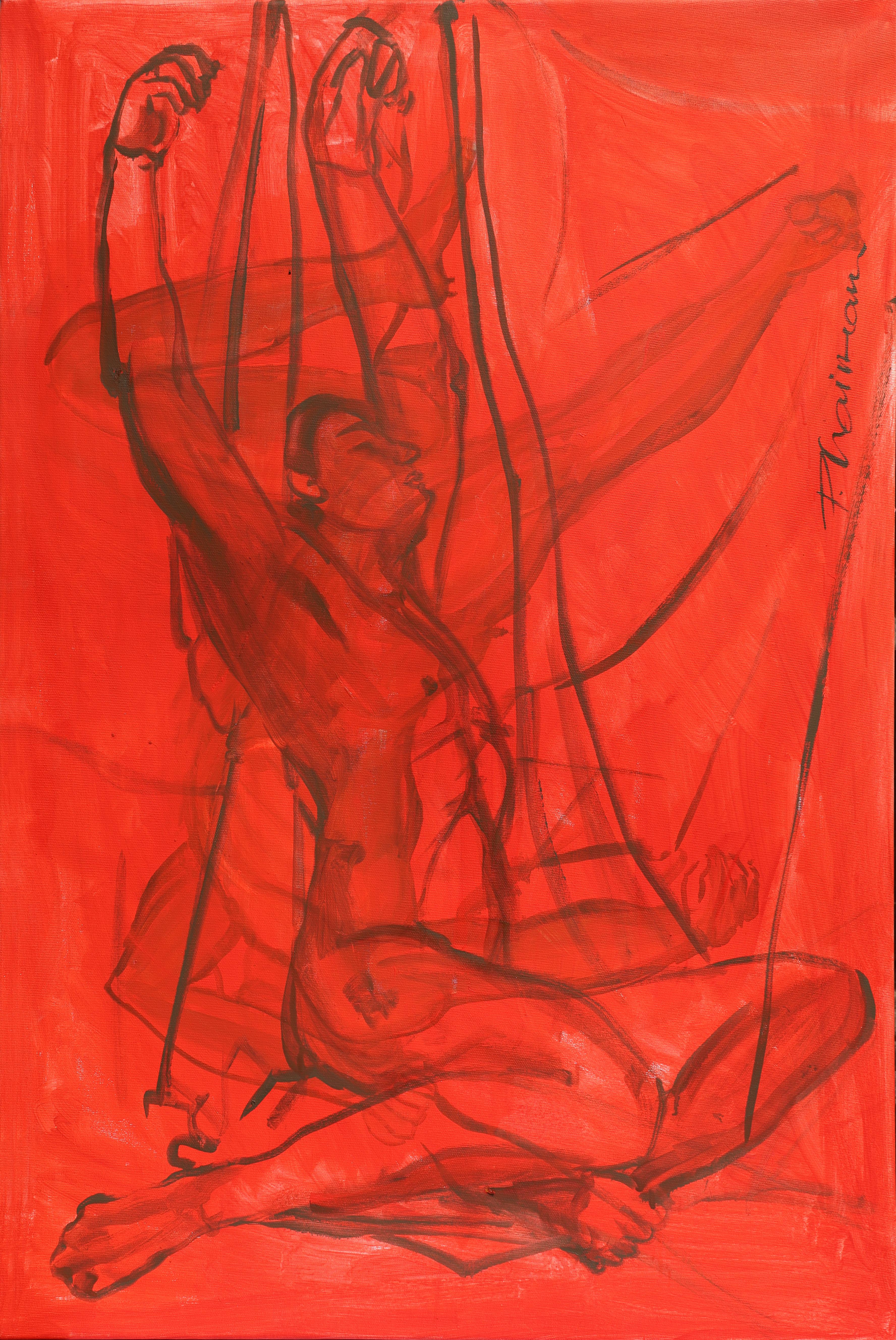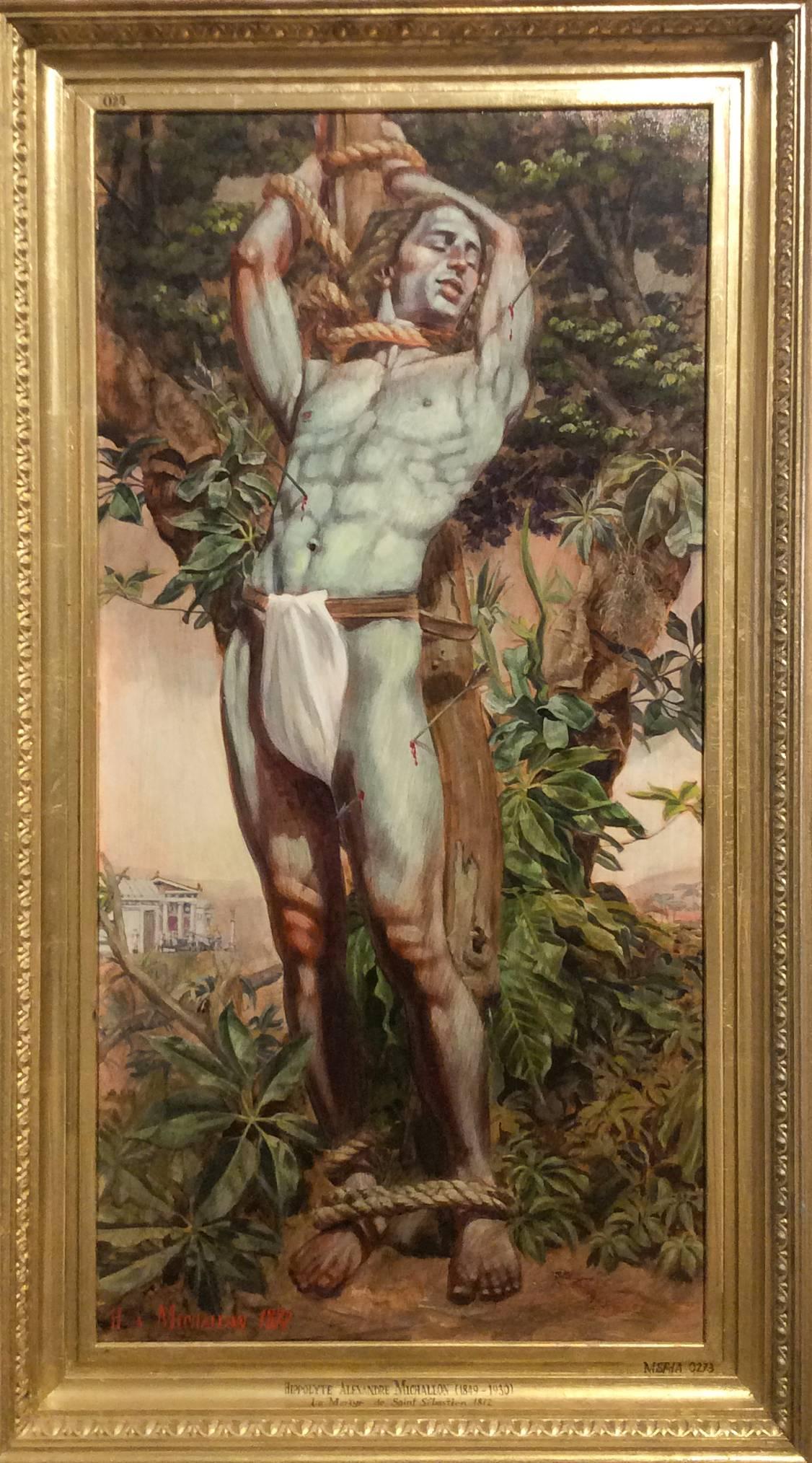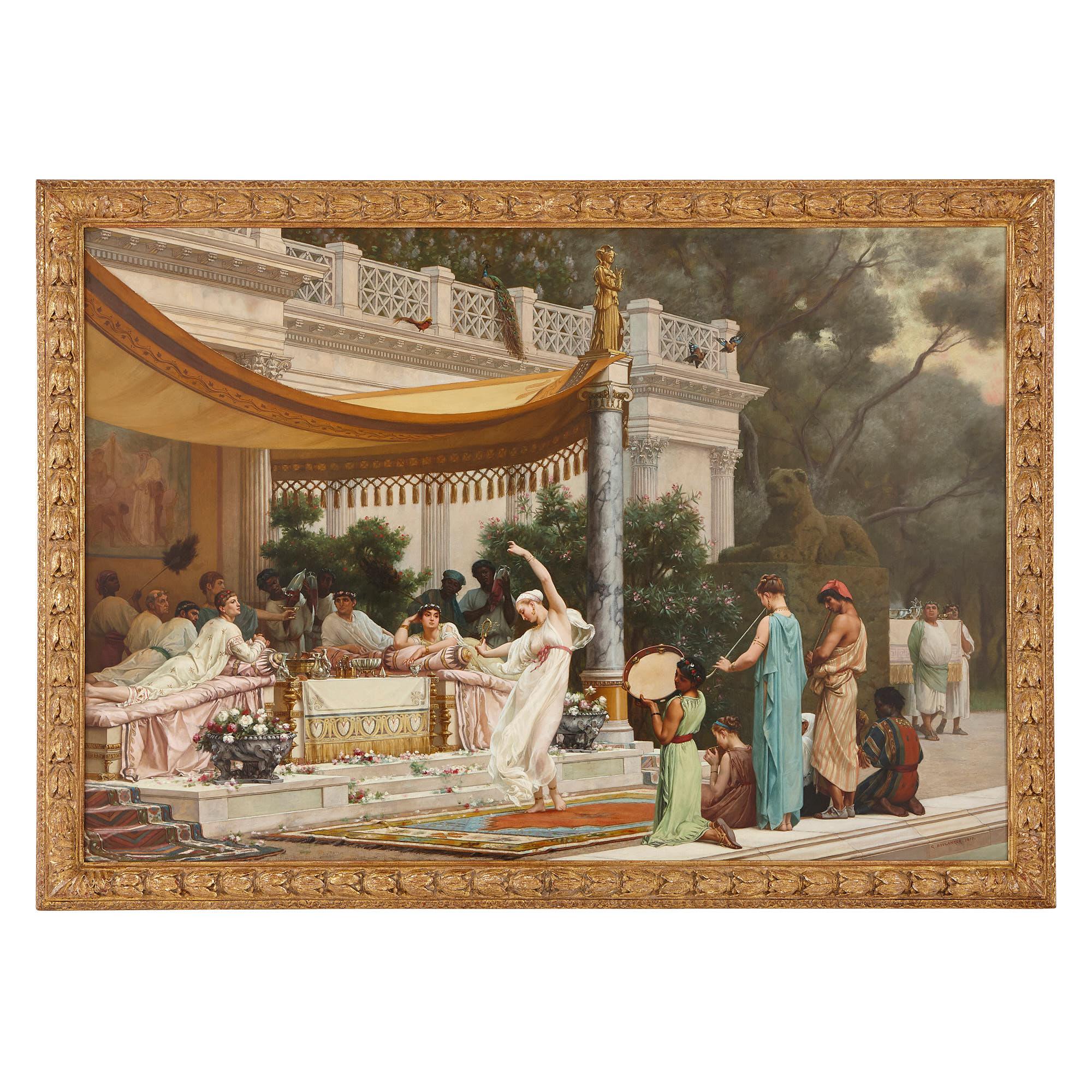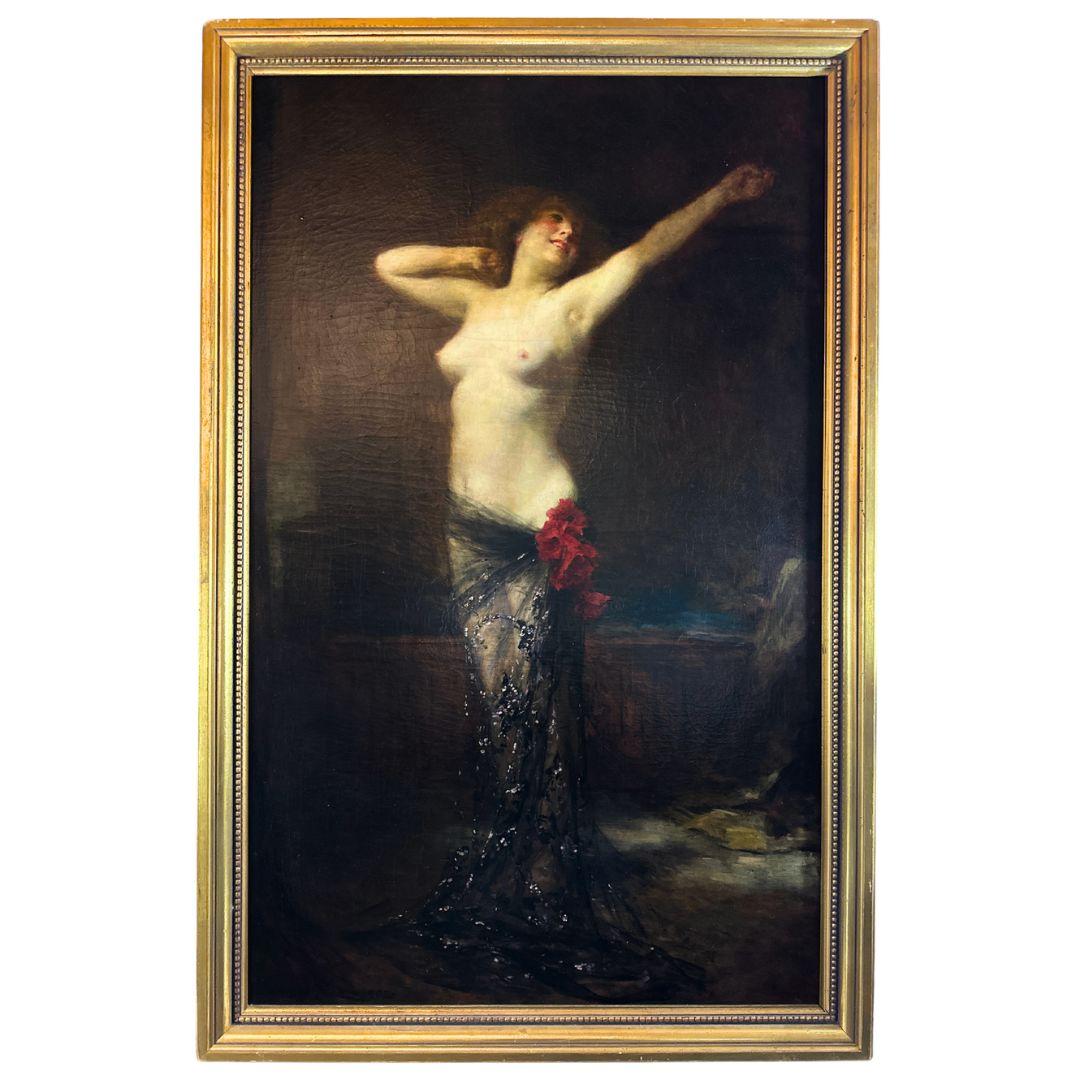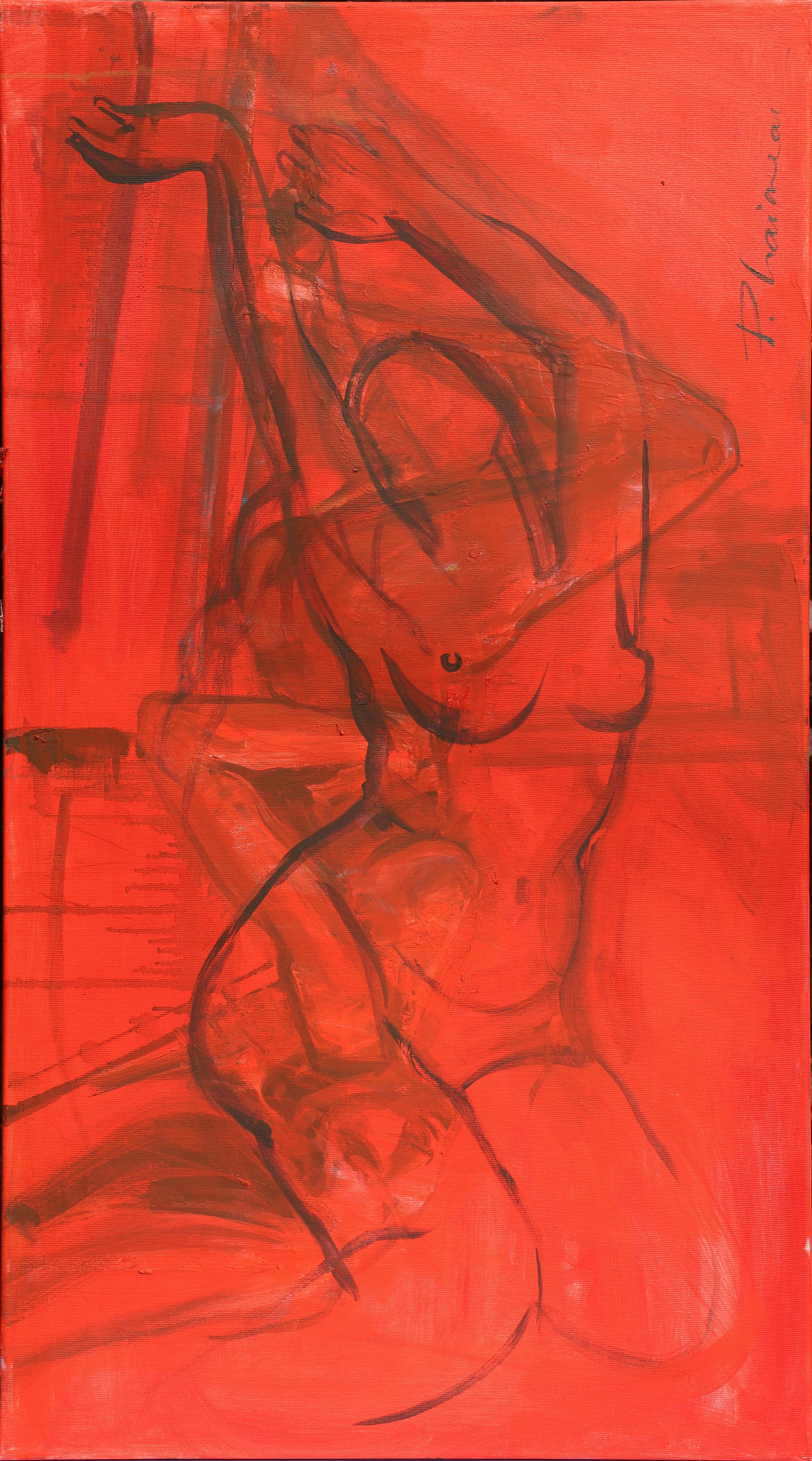Items Similar to Nude woman with roses by famous Latvian painter Janis Rozentāls
Want more images or videos?
Request additional images or videos from the seller
1 of 8
Janis RozentālsNude woman with roses by famous Latvian painter Janis Rozentāls1895
1895
About the Item
Janis Rozentāls was born in 1866 in Saldus, Latvia, to a family with modest means. The son of a
blacksmith, Rozentāls faced economic challenges in his early life, prompting him to move to
Riga at the age of 15 in search of work. Despite his initial attempt at a career as a waiter, he
eventually found his passion for art and became an apprentice to a painter.
After years of hard work, Rozentāls gained admission to the Saint Petersburg Academy of Arts
in 1888, marking the beginning of his formal artistic education. His talent quickly became
evident, and his diploma work, "After Church," garnered significant attention. During his time in
Saint Petersburg, Rozentāls was part of the Latvian artistic and musical group called Rūķis,
reflecting a nationalistic sentiment.
In 1899, Rozentāls returned to Latvia and settled in Riga in 1901. His encounter with Finnish
singer Elli Forssell at a concert in 1902 marked a turning point in his life. Their love story led to
marriage in 1903, and their union influenced not only Rozentāls' personal life but also sparked
his interest in Finnish art.
Rozentāls initially pursued realism in his art but later incorporated influences from impressionism
and symbolism. His wife, Elli, became his muse and appeared in various forms in his paintings,
ranging from Eve to Mary Magdalene, but most commonly as a Madonna. The couple had three
children: Laila, Irja Austra, and Miķelis.
During the summers in Finland, Rozentāls painted sunny portraits, often featuring Elli's relatives.
The Finnish landscape, with its clear lines and almost harshness, left a notable impact on
Rozentāls' artistic style. He expressed a particular interest in summer landscapes, occasionally
incorporating bright autumn colors. However, winter landscapes were a rare subject in his
works.
The outbreak of World War I in 1914 led the Rozentāls family to flee to Finland in 1915.
Rozentāls continued to paint despite the challenges of finding work in a new country. In 1916, he
painted a portrait of the Finnish writer Aino Kallas, among other works, to sustain his family
financially. Tragically, Rozentāls passed away on Boxing Day in 1916 due to a heart attack.
- Creator:Janis Rozentāls (1866 - 1916, Latvian)
- Creation Year:1895
- Dimensions:Height: 24.41 in (62 cm)Width: 13 in (33 cm)
- Medium:
- Movement & Style:
- Period:
- Condition:
- Gallery Location:Brooklyn, NY
- Reference Number:1stDibs: LU1599214026092
About the Seller
5.0
Vetted Seller
These experienced sellers undergo a comprehensive evaluation by our team of in-house experts.
Established in 2007
1stDibs seller since 2021
32 sales on 1stDibs
- ShippingRetrieving quote...Ships From: Brooklyn, NY
- Return PolicyA return for this item may be initiated within 2 days of delivery.
More From This SellerView All
- Portrait of a young womanBy Alexandre CabanelLocated in Brooklyn, NYAlexandre Cabanel (1823–1889) was a prominent French academic painter known for his mastery of Neoclassical and Academic art. Born on September 28, 1823, in Montpellier, France, Caba...Category
Mid-19th Century Academic Portrait Paintings
MaterialsCanvas, Oil
- Lamentation of Christ oil on paper laid on canvasBy Annibale CarracciLocated in Brooklyn, NYThe composition repeats that of a large altarpiece designed by Annibale Carracci for the church of San Francesco a Ripa, Rome (now in the Louvre, Par...Category
Early 17th Century Old Masters Figurative Paintings
MaterialsPaper, Canvas, Oil
- Dans la forêt, Barbizon forestBy Narcisse Virgilio Díaz de la PeñaLocated in Brooklyn, NYNarcisse Diaz de la Peña (1807–1876) was a French painter associated with the Barbizon School, a group of artists who focused on naturalistic landscape painting. He was born on Augus...Category
Mid-19th Century Barbizon School Landscape Paintings
MaterialsCanvas, Oil
- English painting of a woman with her lover returning from the warLocated in Brooklyn, NYSigned bottom-left.Category
Late 19th Century Figurative Paintings
MaterialsOil, Canvas
- Horses, a farmer with a dog in a farmyardBy George MorlandLocated in Brooklyn, NYProvenance: Private Collection, purchased in London, UK, sold by the grandson of a prominent Argentinian businessman who said his grandfather acquired the painting in London sometime between 1910-1920 and has remained in their family until sold to Sebastian Deya...Category
19th Century Realist Figurative Paintings
MaterialsCanvas, Oil
- View of Cape Miseno, Oil on canvas by Edoardo Dalbono, Naples landscapeBy Eduardo DalbonoLocated in Brooklyn, NYThe son of a writer and art critic father and poet mother, Edoardo Dalbono attended the Royal Institute of Fine Arts in Naples in 1853, but left it shortly afterwards to join Nicola Palizzi...Category
Late 19th Century Figurative Paintings
MaterialsOil, Canvas
You May Also Like
- Composition with Two Male Nudes - painting Paula Craioveanu oil on canvasBy Paula CraioveanuLocated in Forest Hills, NY"Composition with Two Male Nudes", oil and silver leaf on canvas, 35.5x23.5in / 90x60cm Part of my Male Nude series. Shipped as it is, stretched, directly from the artist's studio.Category
2010s Academic Figurative Paintings
MaterialsCanvas, Oil
- Le Martyr de Saint Sebastian (Academic Figurative Oil Painting in Gold Frame)By Mark BeardLocated in Hudson, NYAcademic style figurative oil painting on canvas 48 x 24 inches unframed 58 x 32 x 3 inches in gold leaf wood frame This vertical, contemporary figurative painting of Le Martyr de Saint Sebastian was made by Mark Beard under his fictitious artistic persona, Hippolyte-Alexandre Michallon. Painted in a modern Academic style, Beard paints this Christian saint with dramatic detail and emotional gravity. The scene is a common artistic depiction of Sebastian who according to traditional belief, was killed during the Roman emperor Diocletian's persecution of the Christians. Here the artist depicts a nearly nude Saint Sebastian standing stoically while tied to a rustic brown post. A lush green forested terrain decorates the background while a white neo-classical building sits in the distance, which is perhaps the tomb where Saint Sebastian's remains were laid to rest. Saint Sebastian's pale blue-grey, stone-like stone tone is characteristic of Mark Beard's work who often portrays muscular young men similarly to Greek statues. The vertical Academic style figurative oil painting is complimented with a vintage style gold leaf wood frame. The painting is signed 'H. A. Michallon 1872' in red oil paint in the lower right corner. The gold frame is also signed and inscribed with black oil paint in several places (please see images). Mark Beard is a contemporary artist who made this work under the pseudonym Hippolyte A. Michallon who painted during the late 1800's so slight wear (see images) is intentionally staged to align with the factitious artist's purposed history. About the artist: Mark Beard is perhaps the most literal example of an artist pulled in so many different directions that he chose to “invent” six different personae in which to channel his overflowing energy and need for expression. Each painting style is radically different from the next, so it remains entirely believable that the work could stem from six completely different people of different time periods and different schools of thought. With a background in set design, Beard has always been one who could conjure total magic with anything available. Mark Beard has exhibited with Carrie Haddad Gallery for nearly twenty years and there has never been a dull moment. Mark Beard, born in 1956 in Salt Lake city, now lives in New York City. His works are in museum collections worldwide, including the Metropolitan Museum of Art, New York City; the Museum of Modern Art, New York City; the Whitney Museum of American Art, New York City; the Boston Museum of Fine Arts; and the Harvard, Yale, and Princeton University Art Museums; among many others. We would not be the least bit surprised to see new ‘personas’ emerge in the coming years. About: Hippolyte - Alexandre Michallon, 1849 -1930 The long and peripatetic artistic career of Hippolyte-Alexandre Michallon began in a conventional fashion. The only son of prosperous bourgeois parents in Tours, he first studied drawing with his mother, an accomplished amateur painter of insects. His father, an undertaker who appreciated his son's talent and supported his ambition to become a painter, sent him to Paris at age sixteen to enroll in the studio of Francois-Edouard Picot (1786-1868), an eminent history painter and professor at the Ecole des Beaux-Arts, with whom he studied for three years, until Picot's death. Under his aging teacher's guidance and tutelage, Michallon entered the preliminary stages of the Prix de Rome contest at the Ecole three times, winning an Honorable Mention in 1869 for his composition entitled The Solider of the Marathon. For the next twenty years Michallon regualarly exhibited paintings on historical and biblical themes at the Paris Salon, as well as commissioned portraits. By his own account, the most ambitious work of Michallon's career was a thirty-foot canvas depicting Noah's Ark, which he exhibited in the Salon in 1875. Michallon began painting atmospheric but zoologically correct images of exotic animals in the wild. These achieved a certain popularity among French and foreign collectors alike, providing Michallon with financial security for the first time in his career. Michallon moved to England in 1893. His outstanding technical skills easily earned him a position on the faculty of the Slade School of Art in 1900. The craze for animal paintings proved short-lived. He continued to teach at Slade for the next two decades, but his classes gradually dwindled in size as the academic approach and methods he espoused went from outmoded to downright unpopular. Finally in 1922, finding himself reduced to a single pupil, the talented young American Bruce Sargeant, he retired from Slade, persuading Sargeant to leave with him and undergo private instruction at home. Several years later he retired to a cottage at St. Ives, Cornwall, where he lived quietly until his death in 1930, forgotten by all but a few former students, among them Edith Thayer Cromwell...Category
Early 2000s Academic Figurative Paintings
MaterialsCanvas, Oil
- 'A Summer Repast at the House of Lucullus', large oil painting by BoulangerBy Gustave Clarence Rodolphe BoulangerLocated in London, GBThis beautiful painting was created in 1877 by the well-known French painter, Gustave Clarence Rodolphe Boulanger. Boulanger often produced work which combined the classical and Orie...Category
Late 19th Century Academic Figurative Paintings
MaterialsCanvas, Oil
- The Dance 19th-century Large Antique Nude Oil Painting on Canvas, Signed & DatedLocated in Jacksonville, FLExhibited at the Paris Salon, exhibition label on reverse. Description: Édouard François Zier (1837-1924) was a French painter known for his captiva...Category
Early 19th Century Academic Nude Paintings
MaterialsCanvas, Oil
- Echoes 2 - painting Paula Craioveanu oil on canvasBy Paula CraioveanuLocated in Forest Hills, NYEchoes 2 Composition with Two Female Nudes, oil on canvas, 35.5x19.5in / 90x50cm Part of WIngs of Gods, solo show. Shipped as it is, stretched, directly from the artist's studio.Category
2010s Academic Figurative Paintings
MaterialsCanvas, Oil
- Echoes 3 - painting Paula Craioveanu oil on canvasBy Paula CraioveanuLocated in Forest Hills, NYEchoes 3 Composition with Two Male Nudes, oil on canvas, 35.5x19.5in / 90x50cm Part of Wings of Gods solo show, April 2024. Shipped as it is, stretched, directly from the artist...Category
2010s Academic Figurative Paintings
MaterialsCanvas, Oil
